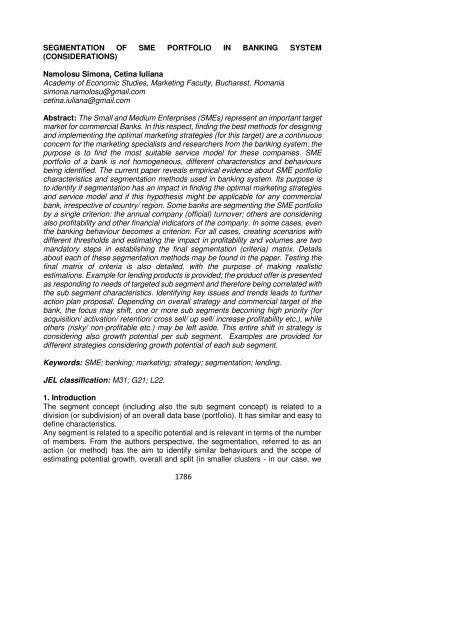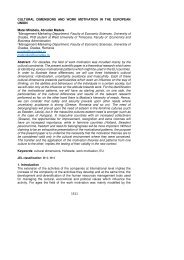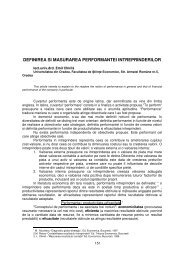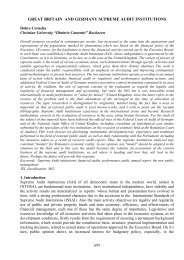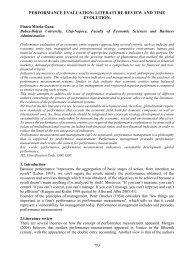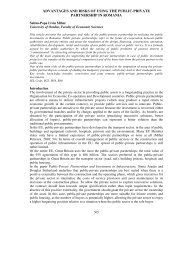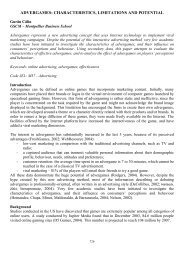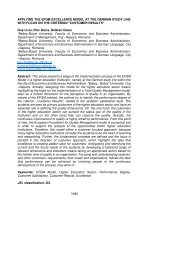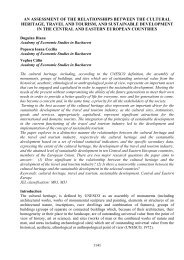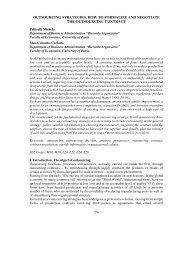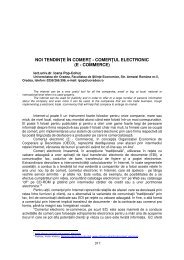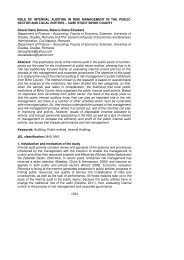SEGMENTATION OF SME PORTFOLIO IN BANKING SYSTEM ...
SEGMENTATION OF SME PORTFOLIO IN BANKING SYSTEM ...
SEGMENTATION OF SME PORTFOLIO IN BANKING SYSTEM ...
Create successful ePaper yourself
Turn your PDF publications into a flip-book with our unique Google optimized e-Paper software.
course, of the profitability gained through offering a crediting facility).The most common segmentation criteria are related to company characteristics:■ Company turnover, profitability and other financial Indicators;■ Field of activity (because the credit risk policy could impose to avoidoffering lending facilities to clients belonging to industries with a highrisk; it’s well - known that, once the economic crisis appeared, thebuilding field of activity suddenly became a sector where credits werebeing offered only as an exception);■ Geographic Region;■ The debt service (including the debt payment to the state budget).Other criteria refer to the banking behaviour:■ Incoming payments - turnover on current accounts;■ Revenue generated for the bank in a certain period of time;■ The banking products held at a certain period of time (usually, the lastavailable reports), compared with the identified products potential■ Volumes (Loans and or Deposits);■ The seniority of the client (beginning with the date when the accountwas opened);■ The payment behaviour, for clients with loans;■ Collateral coverage level;■ The commercial campaigns which had an impact upon the client/whichdidn’t have an impact.An example of segmentation analysis from banking behaviour perspective is shownin the following figure.Figure 2: Banking Behaviour as Segmentation CriteriaSource: Personal Contribution of AuthorsSegments become real targets when the potential is considered large enough andwhen the characteristics and banking behavior of the segments allow a specialpositioning which can create a value proposition for the clients in the segment.From authors’ perspective, a market watch analysis is mandatory, so is a qualitativeresearch in order to identify the most adequate solutions for the implementation. Ifneeded, a testing session will be set up. Before roll-out of the new strategy, a pilot1789
might be done in order to identify aspects to be improved/removed/added.After the implementation, the monitoring of the results and the constantcommunication is very important. Sometimes lack of monitoring may influence theprofitability.Negative signals can be identified after the segmentation is already designed andthe strategy is already set up. This happens because the risk profile and theeligibility of the client is analyzed only after receiving detailed information from eachclient; for example, some filters will include the rating, the debt service, possible tobe made only based on documents (usually financial and legal documents) providedby the client’s representatives.2.2. Characteristics of <strong>SME</strong> Banking ProductsEach <strong>SME</strong> is different and therefore the banking services are unique. Thedependency between the company’s characteristics and the service is very high.For some companies, the service is standard; for others, is tailor made (thisapproach is appropriate to be used for more complex companies and needs).The quality of the banking services for <strong>SME</strong>s is very hard to analyze, especiallybecause the customers’ expectations are hard to anticipate and the evaluation ofthe customer satisfaction can be done only after the banking service is purchased.However, requesting constant feed-back during service providing is very helpful.How a customer perceives the value of the banking product is directly related tocustomer satisfaction with the condition of meeting the expectations. This leads toa need of standardizing the service in order for the customer satisfaction conditionsto be met.When addressing to small companies, customer satisfaction standards are easierto identify, anticipate and design. For a medium company, for example, it isrecommended to address a combination of standard features and tailor made ones.A banking service feature is designed and established through the document calledproduct card (to be noticed that the concept of banking service was replaced bybanking product. Any new product or modification of existing products is approvedthrough this document. The product card contains all the standard features of theproduct and also details about the non-standardized approach (rules of approval,criteria to consider etc.).Sometimes the same product card will be used in order to offer standard productsto a specific segment of clients, while for other segments, the same product cardwill become a tailor made offer through applying the existing non-standard rules.Another special feature of the <strong>SME</strong> banking product is related to the decisionprocess.The term of customer has in the end an individual person that will take a decision.That person could be an administrator, shareholder or general manager of thecompany. For bigger companies, the decision can be taken also by the FinancialManager. Even so, when appreciating the quality of the banking product, or whentaking the decision of acquiring the banking product, the customer (individualdecision maker) is influenced by his own experiences, claims and expectations; theinfluencers can be someone from the family (for example, if a family member had asimilar experience with the same bank/ branch of a bank etc.), a business partner(client, supplier etc.), even subordinates (financial manager, accountant etc.) andother parties (brokers, consultants etc.).1790
Sometimes, situational factors influence the decision (for example lack of parkingspace in the proximity of the branch, no privacy and so on can lead to a negativedecision).While taking the decision to contract a loan, maybe the most important factor is thecredibility and confidence inspired by the Relationship Manager. The explanation issimple: the financial situation of the company is important for any administrator/shareholder (profit is source of dividends and so on) and the risk that a wronglygranted loan could destabilize the financial balance leads to the need of competentadvice. That is why professionalism of the Relationship Manager (proven by verywell knowing the products, understanding the business, financial indicatorsknowledge and so on) may also influence the decision.In authors opinion, the decision is influenced by the ability of the RelationshipManager to inspire confidence, by:■ Very well knowing the banking product, with all its feature (including allcosts)■ Understanding the business of the client and correctly identifying the need(a common mistake of low experienced Relationship Manager is offeringa Working Capital line instead of an Investment Loan; experienced clientsknow very well that the company’s financial situation can be seriouslydamaged if acquiring, for example, fixed assets with 5 years amortization,with a working capital line with maturity of 1 year)■■■■■Continuously providing consultancy and adviceInteractivity and relationship management; the clients need to be involvedin the structuring of the banking product (when tailor made approachneeded). Face to face meetings are a great premise for identifying furtherbusiness opportunities for cross selling and future financing (for example,in the meeting, the client may mention a small detail regarding a futureinvestment for building a new warehouse)The quality of the banking product cannot meet the clients’ expectationsunless the Relationship Manager demonstrates fairness; this approachneeds to be part of organizational culture, as the values reflect in day today activityTrained on soft skills development: communication, sales, negotiation etc.are a mustBecoming a single point of contact with the client, “the bank is me”; highexpertise and very well knowing the business, together with financialadvice and well knowing to identify the needs, are the features that makea Relationship Manager become the face of the bank in front of thecustomer. That is why the entrepreneurship skills are also very important.As a conclusion, the skills and know-how of the Relationship Manager might bedefining for the decision taking regarding loan facilities. Knowing very well theseaspects, the members of the marketing department could be very interested inapplying the marketing strategies first of all by “selling” them to the RelationshipManagers. The scope is very well illustrated in the figure below.Figure 3: Marketing Strategy Leading to Commercial Results IncreaseSource: Personal Contribution of Authors1791
financing; F) and the cost of risk (as described above, CoR).For calculation of the profitability of the loan, the authors are proposing the followingformula:RL = IF- FC - CoR, where: RL = net Revenues generated through the Loan; FC = financing cost; CoR = Cost of the Risk.3.2. <strong>SME</strong> Lending – StrategiesEvery banking product strategy follows at least three essential stages: the Designstage, the Implementation stage (which includes: the release itself, the testing –before and/or after the release – and the “technical” implementation) and thesubsequent Monitoring (with the purpose of identifying the strengths or the possibleoptimization alternatives; sometimes it leads even to a radical strategy change).The effort while designing a strategy is orientated towards the existing clients’portfolio. This is widely accepted as being an efficient strategy, being less expensivethan the strategy of attracting new clients. It is also profitable to simultaneously focuson various transactional segments. The portfolio selection (clean-up) andsegmentation is applied for developing a model, taking also into account aperspective based on risk management - clients with less risk and high profitabilityare preferred.Once the market segment/segments have been defined, the establishment of thecrediting strategy target is made taking into consideration the potential of the chosensegment (which has to be large enough), but especially the possibilities of creatinga special positioning, that will be able to generate a value proposition for the clientswithin the segment.After establishing the target segment characteristics, the companies whose riskprofile don’t meet the eligibility conditions will be eliminated from the database. Theconditions will always include the company’s financial rating (based on the scoringdeveloped by the financial institution), the debt service, the client’s profitability andso on.A competition analysis is a mandatory step, especially when the target segment iscomposed of small companies. In this case, the strategy will be a standard one,generally available for all companies included in the segment. For larger companies,where a level of service personalization appears, the competition analysis becomesharder, reflecting through the clients who are willing to offer information regardingthe offers which they received from the competing banking institutions.The strategic alternatives when offering credit facilities may regard any aspectbelow, but the decision regarding optimal strategy could be taken at segment level: The market share increase, by increasing the number of clients with creditsand/or the total volume of granted loans; if focusing on volumes, the segmentswith highest potential should be attacked. Optimized version/ new version or product to be included into the productcatalogue of one or more segments; segments with low results and potentialcan be attacked by offering optimized products which meet their expectations. Client portfolio migration from credit products with a higher risk to credit facilitieswith lower risk and/or higher profitability (transforming the credits with work1793
capital into factoring facilities, for which the default risk is lower); segments withhigh risk (sensitive portfolio) always need a special strategy and action plan. The creation of products and services “packages” (for cost optimizing); elite andcomplex segments can be attacked with innovative products which are leadingto turnover increase through the bank (and therefore to non-risk revenueincrease); for example, a package with unlimited incoming and outgoingpayments and a lot of banking and non- banking benefits included, at a monthlyfixed price. The establishment of loyalty methods for the existing clients/acquisition of newclients through a simplified flow of offering certain credit facilities (for example,preapproved facilities); segments with good financial performance and with loanappetite will be attracted through a pre-approved limit of money (working capitalor credit card), granted by a very simple flow, with no bureaucracy. Encouraging certain favorable behaviors (the turnover increase through thecurrent account, which leads to the banking institution’s profitability increase),by offering preapproved working capital lines (according to the client’s previousbehavior) Some modifications of the existing products are mandatory due to legal rules(especially NBR Regulations, Available: http://bnro.ro/Legislatie-financiarbancara-735.aspx).Different strategic alternatives for each segment will be proposed, taking intoaccount also the cluster specificities and the objectives that derive from the analysis.For profitable clients but without growth potential the optimal strategies are focusedon retention; for unprofitable clients but with a high potential, the optimal strategywill consider the increase of the turnover through the bank, the increase of theproduct penetrating degree or the increase of the credit volume.4. <strong>SME</strong> Strategy Efficiency – Final TestingBased on criteria defined in segmentation activity, and also through differentscenario defining, final thresholds for each numerical criterion will be defined. Inorder to estimate the results of the marketing strategy, worst case and best casescenarios will be set up. An example for 3 months evolution is provided in the figurebelow.Figure 4: Three Months Evolution: Best and Worst Case Scenarios (Estimations)Source: Personal Contribution of Authors1794
Usually, the final estimation for the strategy is somewhere in between worst andbest case. The next step is represented by testing the matrix of criteria, which isusually made through a pilot (branch/ region/ indicated financial advisors, in a limitedperiod of time). After the pilot period, a “Before and After” analysis should beperformed, with the purpose of comparing the average (monthly/ quarterly) beforelaunching to the average of the same indicator, but after launching. This is the finalanalysis, through which, the efficiency/ inefficiency of the designed segmentation isdetermined (as per the below figure).Figure 5: Before and After Analysis of the Strategy ImpactSource: Personal Contribution of AuthorsDepending on the strategy profitability and success, further analysis and monitoringof the segments will be done. Best Practices for sub segments may be identified,and, therefore, an optimization of the strategy could be done.Concluding DiscussionConsidering the methods and strategies presented in the current paper, one canidentify correlation and impact between portfolio analysis, market watch, bestpractice identifying, gathering feed-back (from best sales representatives andclients), analysing the clients profiles and the action plan (as a starting point) of anefficient segmentation process. In this respect, the defining of segments and subsegments may be based on different criteria identified as important during thepreviously mentioned analysis. If willing to determine if a segmentation structure(matrix) is efficient or not, business case scenarios could be tested. Tailor madestrategies may be designed for sub segments by very well knowing the profile,characteristics and behaviour. This is why authors consider that segmentation hasan important impact in finding the optimal marketing strategies and service model.<strong>SME</strong> specificity and characteristics may be found not only in Romania, but also inother countries and regions. Targeted products, behaviour similarities identificationand profitability estimation could be done for clusters of companies all over theworld. This is why, one can conclude that segmentation methods and strategiespresented in the current paper could be applicable to any commercial bank,irrespective of country or region.1795
ReferencesBerry, L., Bennett, D. and Brown, C. (1989) Service Quality. A Profit Strategy forFinancial Institutions, Illinois: Dow Jones – Irwin, Homewood, Illinois.Cetină, I. (2005) Marketing Financiar Bancar, Editura Economică, București.Cetină, I. and Odobescu, E. (2007) Strategii de Marketing Bancar, EdituraEconomică, București.Harrison, T. (2000) Financial Services Marketing, Prentice Hall, Great Britain.Ionescu, L. (2001) Elemente de marketing bancar, Institutul Bancar Român,București.Kotler, P. (2008) Managementul Marketingului Editia a V-a, Editura Teora,București.Olteanu, V. (2007) Marketing financiar bancar, Editura Ecomar, București.Oncioiu, I. (2012) Small and Medium Enterprises’ Access to Financing – AEuropean Concern: Evidence from Romanian <strong>SME</strong>, International BusinessResearch, Vol. 5, No.8, pages 47-57, Published by Canadian Center of Science andEducation.Silivestru, D. (2012) Bank Loans and Small Firm Financing in Romania, AnnalesUniversitatis Apulensis Series Oeconomica, 14(1), pages 178-188, Alba Iulia.[online] National Bank of Romania http://bnro.ro/Legislatie-financiar-bancara-735.aspx1796


